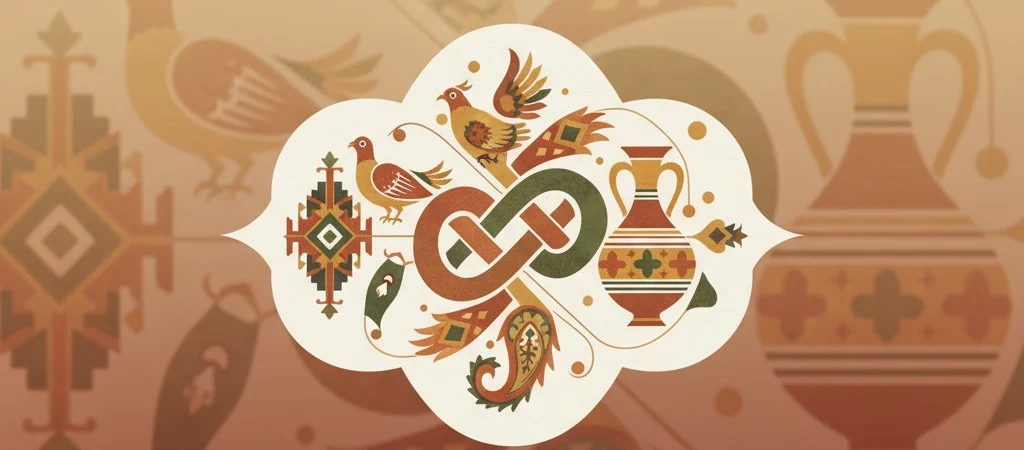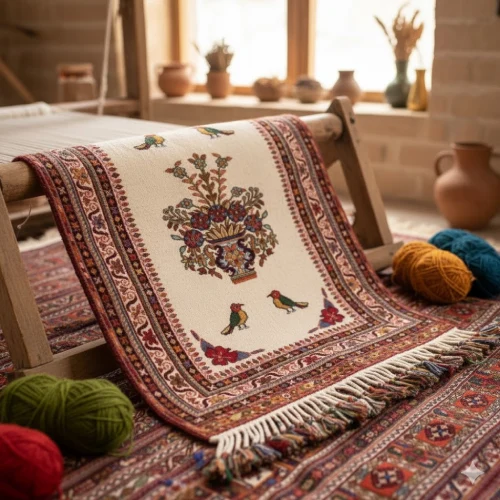
Kilim



story of Jajim
Kilim is a flat-woven textile made of warp and weft, often crafted from the wool of domestic animals on a carpet loom. Traditionally, it has been used as a floor covering. The word Kilim is of Persian origin, though in ancient times it was also known as Pelas—both names appear in the works of poets such as Ferdowsi and Hafez. Sometimes, kilims were woven for other purposes among nomads—such as for salt bags, saddle covers, or tent bands. In classical Persian literature, Kilim was often mentioned alongside words like Zilu or Jajim with similar meanings. However, technically, a kilim is woven by interlacing the weft threads through upright warps stretched on a loom—without using any tools such as shuttles or bobbins. This is one of the main distinctions between kilim and textiles like zilu or jajim.
A Kilim (or Pelas) is one of Iran’s traditional handwoven floor and covering crafts, made from wool, goat hair, silk, or a mix of fibers from domestic animals. Traditionally, it served as a floor covering, wall hanging, or animal blanket, but today it has become a stylish decorative item for modern homes. The colors used in traditional kilims are natural dyes. To achieve a more antique appearance, some kilims are washed with tea or walnut husks. There is no fixed size for kilims; nomadic weavers have always made them in whatever dimensions best suited their needs—from small pieces to large rugs.
Jajim (also spelled Jajm) is a double-sided woven fabric. It’s a thick handwoven cloth, similar to kilim but finer and lighter, made of colorful wool or cotton threads—or a mix of both. Jajim has no pile, and both sides can be used. It was widely used by nomads as a blanket or warm cover and was once the most common item spread over a traditional Iranian korsi (a low, heated winter table). With the disappearance of korsi heating and the rise of modern urban life, jajim weaving declined in towns, yet many rural women still continue this craft, setting up their simple looms in courtyards or open spaces and weaving throughout the year.
Jajim weaving remains popular across many provinces of Iran, including Gilan, Mazandaran, East Azerbaijan, Ardabil, Kerman, Kermanshah, Kurdistan, Ilam, Hamedan, Lorestan, South Khorasan, and Fars. Traditionally, jajims were used as floor coverings or to wrap and transport household goods during nomadic migration. They also served as warm blankets, and in some rural communities, jajims were given as wedding gifts or dowries—treasured family heirlooms passed down through generations. The main material used in jajim weaving is wool. Its weaving technique resembles that of kilim, with the difference that jajim is woven in four long strips that are later sewn together. In regions such as Oraman and Salas Babajani, women weave exceptionally fine jajims with intricate patterns and high-quality yarns.
To begin, colored yarns are prepared, and the process called chale-keshi (warp laying) starts. This is usually done outdoors, similar to carpet warping, by stretching threads around four wooden pegs arranged in a rectangular layout—typically 10 to 20 meters long. The colored wool yarns are wound repeatedly around these pegs, forming the warp threads that determine the final width of the jajim strip.
As the yarns are wound, the color arrangement and design take shape, since jajim patterns are created on the warp itself. One skilled person, called the Kooji-gozar, sits at one end and guides the process, placing cross-sticks (koojee) to separate the layers of yarns—an essential part of warping. After finishing the warp, it is stretched on the ground, secured at both ends with stakes, and attached to a tripod frame from which the weaving begins.
Because the process requires long space, jajim weaving is often done outdoors in village alleys or fields—a practice known as deraz kardan-e jajim (“stretching the jajim”). When work stops, the warp is easily rolled up and stored until weaving resumes.
Dyeing Traditionally, the yarns used for kilim and jajim are dyed with natural materials—a tradition that continues today in authentic handmade pieces. These dyes are mostly derived from plants and minerals, though some come from animal sources, such as cochineal.
Usually, the warp yarns—often made of wool—are dyed before weaving. The combination of these naturally dyed threads gives rise to the variety of patterns seen in kilims.
• Warp (Taar): Usually made of cotton, though some kilims are woven with wool warps.
• Weft (Pood): Typically wool from domestic animals. In finer, decorative kilims, kork (fine underwool) is also used.
• Kilim is a flat weave, while jajim is more dense and interlaced.
• Kilim is woven from wool and cotton, but jajim is mostly wool.
• Jajim is generally thinner and finer than kilim.
• Kilim designs are geometric and often complex; jajim patterns are simpler, usually striped.
The art of weaving kilims is practiced across Iran, and each region’s kilims are recognizable by their unique materials, colors, and motifs.
• Shahsavan Kilim
• Lori Kilim
• Sistani Shawl (Geli or Shaal)
• Hersin Kilim
• Eslamabad-e Gharb Kilim
• Baluchi Kilim
• Khamseh Kilim
• Sanandaj (Seneh) Kilim
• Qashqai Kilim
• Afshar Kilim
• Zarand Kilim
• Turkmen Kilim
• Masnad Anbaran Kilim
• Nakhchivan Kilim
• And finally, Modern Kilims
• Linear or Striped (Moharramat / Afshari)
• Shamloo Design
• Shiraki-Pich (Twined)
• Kurdish Tablecloth (Sofreh) Design
• Plain Field
• Striped (Rah-Rah)
• Geometric Frame (Kheshti or Qab-Qab)
The art of carpet weaving, along with kilim and jajim production, dates back thousands of years. These beautiful crafts are among Iran’s most treasured cultural souvenirs, and every visitor to Iran dreams of owning one of these timeless works of art. We hope to welcome you soon to Iran—particularly to Kermanshah—to visit our kilim and jajim workshops in person. The SANA Persian Team is ready to arrange your visit to Kermanshah in the shortest time possible.
Contact Us
+989054577261